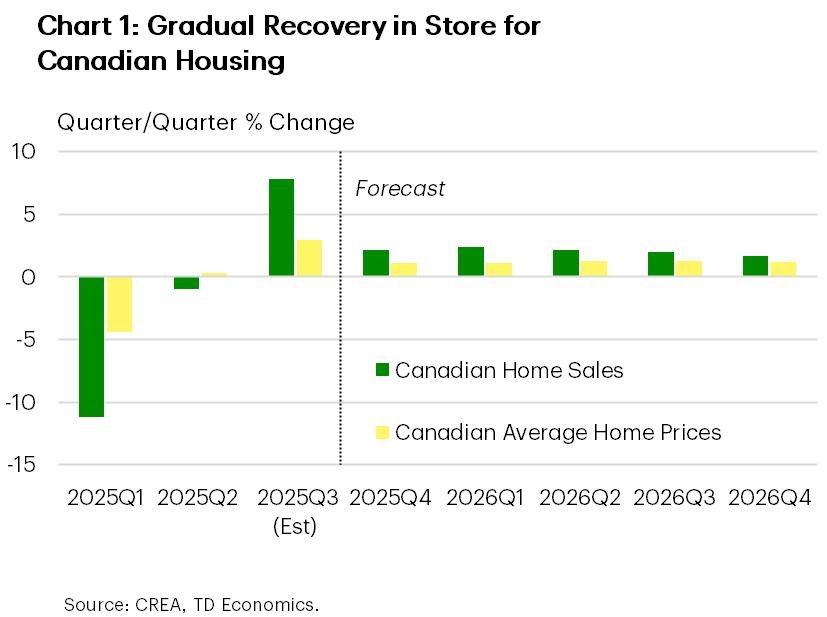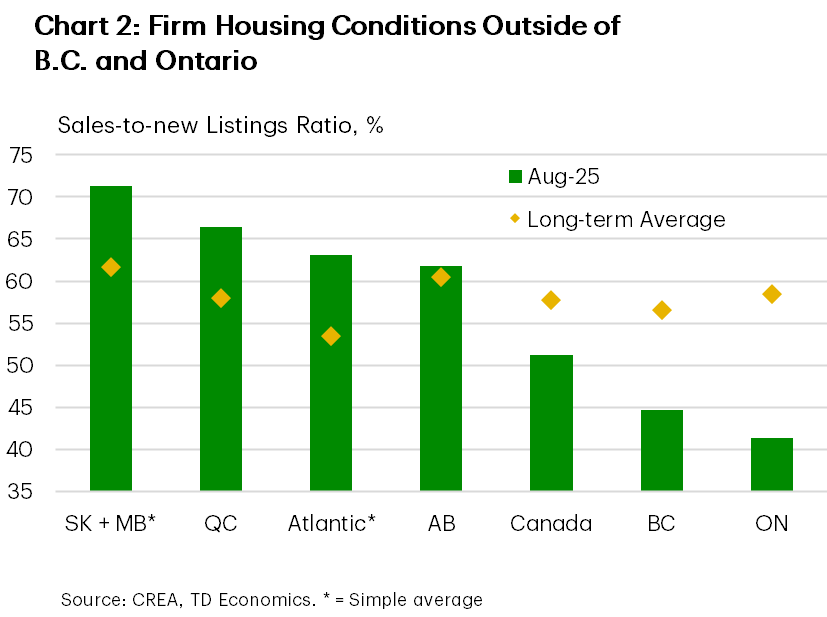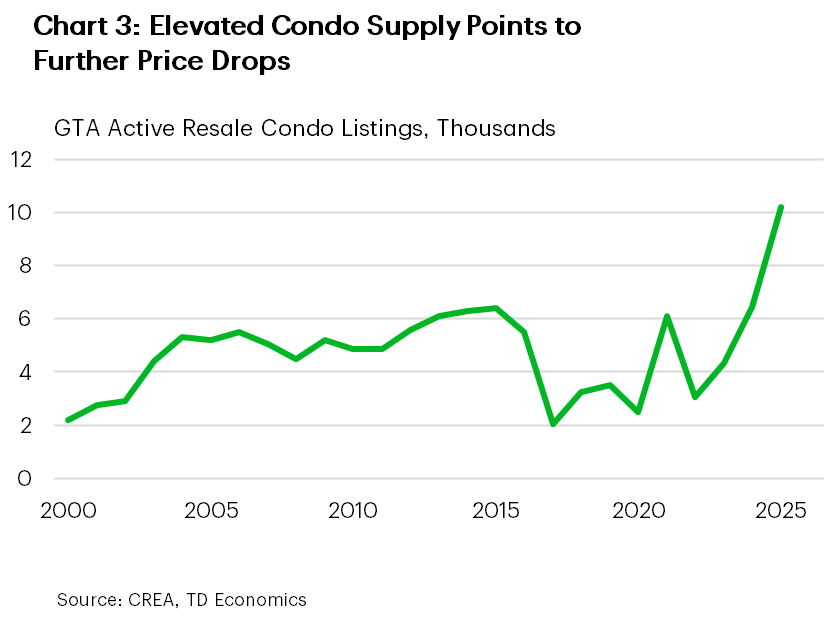Provincial Housing Market Outlook:
Location, location, location
Rishi Sondhi, Economist | 416-983-8806
Date Published: October 2, 2025
Highlights

- We’re tracking somewhat firmer third quarter growth for Canadian home sales than we expected in June. This implies that pent-up demand built earlier in the year (amid peak uncertainty) returned at a larger-than-expected magnitude. This notion is laid bare by the upside surprises in B.C. and Ontario, where pent-up demand is the largest. However, this stronger Canadian sales performance implies that go-forward gains don’t have to be as firm to still be in line with demographically supported sales levels. Accordingly, we’ve downgraded quarterly sales growth in 2025Q4 and through much of 2026 (Chart 1).
- Our downgraded sales growth forecast reflects the narrative of a gradual, modest recovery in the housing market. Near-term drivers include some modest additional Bank of Canada interest-rate relief and the continued return of pent-up demand. In 2026, an improving Canadian jobs market should support activity (see updated economic and interest rate forecast tables here).
- Like sales, Canadian average home price growth was firmer-than-anticipated in Q3. Average home prices are boosted when more expensive units sell better than their cheaper counterparts. So, robust sales growth in the expensive markets of B.C. and Ontario, and the outperformance of pricier properties within these markets, lifted national average transaction prices. We assume these so-called “compositional forces” will sustain into the end of 2025 and have upgraded our near-term Canadian average home price forecast accordingly. For 2026, we’ve downgraded Canadian quarterly average price growth a touch largely reflecting softer sales gains. Still, the 5% price advance projected next year is healthy and consistent with a national market that is likely to remain roughly in balanced territory.
Prairies:

- Saskatchewan seems to have taken the mantle as the hottest housing market in the country this year, with annual price growth in excess of 10% in four of eight months so far. Robust job growth is helping to underpin incomes and housing demand in the province, and we expect the provincial economy to stay an outperformer over the forecast horizon (see our updated Provincial Economic Forecast here). At the same time, affordability remains relatively decent, even with recent price gains, and listings continue to run below their long-term average. Accordingly, markets are drum-tight (Chart 2), portending solid price gains into 2026. However, hiring should cool in 2026 after a robust 2025 performance, sapping some steam from price growth as the year progresses.
- The same forces at play in Saskatchewan (namely relatively firm job/population growth and low listings) are shaping solid price gains in Manitoba. So far in 2025, year-on-year average price growth has averaged 7%. Tight conditions should underpin healthy-near term gains. However, with economic and job growth projected to remain tepid next year, price gains are likely to cool to a below-trend pace in the back half of 2026.
- Current housing dynamics are different in Alberta, where the market has rapidly shifted from ultra-tight to balanced. Sales have dropped amid uncertainty and some slackening in previously rip-roaring population growth. Listings have also climbed above their long-term average, as sellers list amid what was recently the hottest housing market in Canada. However, these same sellers now face more competition from listings and a weaker demand backdrop, and price growth has diminished accordingly. And in fact, some ebbing in price pressures is likely welcomed given that they were advancing at double-digit annual rates as recently as late-2024. This more balanced starting point helps to underpin our expectation of trend-like price increases moving forward.
Quebec and the Atlantic region:
- Despite a deteriorating economic backdrop and eroded affordability, Quebec’s housing market has shown some surprising resilience. Sales barely retraced their healthy 2024 activity even during peak uncertainty earlier this year, and were nearly 30% above long-term averages, on a per capita basis, in August. At the same time, some durability in Quebec’s jobs market has limited the upside pressure on listings, keeping supply/demand balances tight. These tight conditions should keep price growth robust in the near term, although we see Quebec’s quarterly price growth easing in the back half of next year. Indeed, Quebec’s heightened exposure to the Canada-U.S. trade war points to some deterioration in the job market.
- Housing markets in the Atlantic region share some features, including generally tight conditions with low levels of supply, and significant affordability deteriorations in the post-pandemic world. However, sales levels are holding up relatively well in PEI and Newfoundland and Labrador. The latter province rarely steals the spotlight in terms of housing, but it’s notable that year-on-year price growth is trending at a near 10% pace and, unlike other regions, affordability is still well within typical norms (supporting the elevated sales level). Robust population growth has likely been a key common factor underpinning solid price growth in the Atlantic in recent years (note that Nova Scotia and New Brunswick’s home prices were between 80-90% above their pre-pandemic level in August). And, as population growth slows rapidly across the region, we see price growth moderating to a sub-trend pace across most of the Atlantic in 2026. Newfoundland and Labrador is an exception, as it can probably keep above-average price growth for a bit longer given its very tight starting point.
B.C. and Ontario:

- B.C. and Ontario remain the weakest housing markets in the country and are the only two provinces where prices are likely to decline this year. With listings above their long-term norms, buyers have plenty of choice and the upper hand in negotiations (Chart 2). As such, price growth is likely to stay weak through much of 2026, even as sales activity gets supported by the return of pent-up demand, ample choice for buyers, and improving job markets. The GTA condo market continues to be a notable soft spot, even with some improvement in sales activity in recent months. Listings remain highly elevated (Chart 3), and further price concessions are probably required before the market achieves a more balanced position. Helping grease the wheels is the fact that condo completions are dropping rapidly, and affordability in the condo space has improved due to dropping prices. In fact, pandemic-era price gains in the GTA condo market have all but evaporated.
- Risks to the forecast include the possibility that near-term sales growth is weaker than projected if households take more of a breather after firm activity in Q3. The mortgage renewal wave could upwardly pressure supply if investors can’t handle higher rates and thus have to sell. The upcoming CUSMA negotiations also loom large for the economy and, by extension, the housing market. On the upside, we may be underestimating the scale of pent-up demand and the speed at which it bounces back. We must also be mindful that housing activity has had some tendency to surprise expectations to the upside in the past.
Forecast Table |
|---|
| Home Sales and Price Outlook |
Disclaimer
This report is provided by TD Economics. It is for informational and educational purposes only as of the date of writing, and may not be appropriate for other purposes. The views and opinions expressed may change at any time based on market or other conditions and may not come to pass. This material is not intended to be relied upon as investment advice or recommendations, does not constitute a solicitation to buy or sell securities and should not be considered specific legal, investment or tax advice. The report does not provide material information about the business and affairs of TD Bank Group and the members of TD Economics are not spokespersons for TD Bank Group with respect to its business and affairs. The information contained in this report has been drawn from sources believed to be reliable, but is not guaranteed to be accurate or complete. This report contains economic analysis and views, including about future economic and financial markets performance. These are based on certain assumptions and other factors, and are subject to inherent risks and uncertainties. The actual outcome may be materially different. The Toronto-Dominion Bank and its affiliates and related entities that comprise the TD Bank Group are not liable for any errors or omissions in the information, analysis or views contained in this report, or for any loss or damage suffered.
Download
Share: